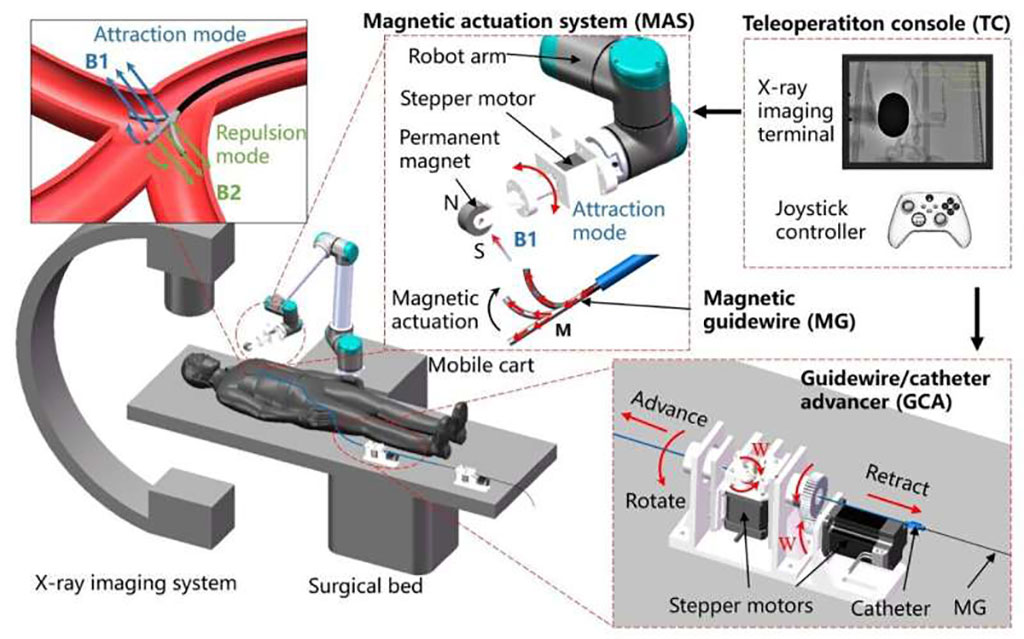Magnetically Controlled Guidewire Robot System for Vascular Interventional Surgery Reduces Radiation Exposure
|
By HospiMedica International staff writers Posted on 12 Sep 2023 |

Vascular interventional surgery is a specialized medical procedure that uses medical imaging, guidewires, catheters, and other tools to diagnose and treat vascular issues. While effective, this kind of surgery exposes physicians to radiation as they need to keep an eye on the guidewire's position under contrast. To address this challenge, scientists have now designed a Magnetically Controlled Guidewire Robot System (MCGRS) that is equipped with magnetically active steering and autonomous propulsion capabilities.
Researchers from the Shenzhen Institute of Advanced Technology (SIAT) of the Chinese Academy of Sciences (Beijing, China) have built a new system that allows physicians to control the guidewire remotely, making it easier to navigate through complex vascular networks and reducing their exposure to radiation. To achieve this, the researchers fixed a piece of magnetic hydrogel material at the tip of the guidewire, allowing it to be maneuvered under the influence of an external magnetic field. The position of the guidewire is confirmed through an imaging mechanism.
To make this system effective, the researchers utilized a combination of the dipole model and the Cosserat-rod model to create a continuum mechanics model. This model can predict the bending of the guidewire tip. In addition, a trajectory planning algorithm was developed to determine the movement and speed of the external magnet based on the path of the blood vessels, enabling autonomous control. The system's capabilities were validated through experiments which confirmed that it could anticipate and adjust for the guidewire tip's nonlinear movements.
During tests, physicians were able to remotely guide the magnetic guidewire to its intended destination through a vascular phantom model's right internal carotid artery. They achieved this while standing outside the operating room, guided in real-time by digital subtraction angiography images. The procedure was completed in approximately two minutes. Moving forward, the team plans to enhance the smart controls of the MCGRS to further aid physicians in conducting these specialized surgical procedures more effectively and safely.
"We realized autonomous control of the magnetic guidewire,” said Prof. Xu Tiantian from SIAT. “It was controlled by a magnetic field to reach the four target locations of the middle cerebral artery from the puncture point through four different paths in a 3D vascular phantom according to the known vascular paths, and the arrival time was less than two minutes."
Related Links:
Chinese Academy of Sciences
Latest Surgical Techniques News
- Pioneering Sutureless Coronary Bypass Technology to Eliminate Open-Chest Procedures
- Intravascular Imaging for Guiding Stent Implantation Ensures Safer Stenting Procedures
- World's First AI Surgical Guidance Platform Allows Surgeons to Measure Success in Real-Time
- AI-Generated Synthetic Scarred Hearts Aid Atrial Fibrillation Treatment
- New Class of Bioadhesives to Connect Human Tissues to Long-Term Medical Implants
- New Transcatheter Valve Found Safe and Effective for Treating Aortic Regurgitation
- Minimally Invasive Valve Repair Reduces Hospitalizations in Severe Tricuspid Regurgitation Patients
- Tiny Robotic Tools Powered by Magnetic Fields to Enable Minimally Invasive Brain Surgery
- Magnetic Tweezers Make Robotic Surgery Safer and More Precise
- AI-Powered Surgical Planning Tool Improves Pre-Op Planning
- Novel Sensing System Restores Missing Sense of Touch in Minimally Invasive Surgery
- Headset-Based AR Navigation System Improves EVD Placement
- Higher Electrode Density Improves Epilepsy Surgery by Pinpointing Where Seizures Begin
- Open-Source Tool Optimizes Placement of Visual Brain Implants
- Easy-To-Apply Gel Could Prevent Formation of Post-Surgical Abdominal Adhesions
- Groundbreaking Leadless Pacemaker to Prevent Invasive Surgeries for Children
Channels
Critical Care
view channel
Ingestible Smart Capsule for Chemical Sensing in the Gut Moves Closer to Market
Intestinal gases are associated with several health conditions, including colon cancer, irritable bowel syndrome, and inflammatory bowel disease, and they have the potential to serve as crucial biomarkers... Read moreNovel Cannula Delivery System Enables Targeted Delivery of Imaging Agents and Drugs
Multiphoton microscopy has become an invaluable tool in neuroscience, allowing researchers to observe brain activity in real time with high-resolution imaging. A crucial aspect of many multiphoton microscopy... Read more
Novel Intrabronchial Method Delivers Cell Therapies in Critically Ill Patients on External Lung Support
Until now, administering cell therapies to patients on extracorporeal membrane oxygenation (ECMO)—a life-support system typically used for severe lung failure—has been nearly impossible.... Read morePatient Care
view channel
Portable Biosensor Platform to Reduce Hospital-Acquired Infections
Approximately 4 million patients in the European Union acquire healthcare-associated infections (HAIs) or nosocomial infections each year, with around 37,000 deaths directly resulting from these infections,... Read moreFirst-Of-Its-Kind Portable Germicidal Light Technology Disinfects High-Touch Clinical Surfaces in Seconds
Reducing healthcare-acquired infections (HAIs) remains a pressing issue within global healthcare systems. In the United States alone, 1.7 million patients contract HAIs annually, leading to approximately... Read more
Surgical Capacity Optimization Solution Helps Hospitals Boost OR Utilization
An innovative solution has the capability to transform surgical capacity utilization by targeting the root cause of surgical block time inefficiencies. Fujitsu Limited’s (Tokyo, Japan) Surgical Capacity... Read more
Game-Changing Innovation in Surgical Instrument Sterilization Significantly Improves OR Throughput
A groundbreaking innovation enables hospitals to significantly improve instrument processing time and throughput in operating rooms (ORs) and sterile processing departments. Turbett Surgical, Inc.... Read moreHealth IT
view channel
Printable Molecule-Selective Nanoparticles Enable Mass Production of Wearable Biosensors
The future of medicine is likely to focus on the personalization of healthcare—understanding exactly what an individual requires and delivering the appropriate combination of nutrients, metabolites, and... Read more
Smartwatches Could Detect Congestive Heart Failure
Diagnosing congestive heart failure (CHF) typically requires expensive and time-consuming imaging techniques like echocardiography, also known as cardiac ultrasound. Previously, detecting CHF by analyzing... Read moreBusiness
view channel
Expanded Collaboration to Transform OR Technology Through AI and Automation
The expansion of an existing collaboration between three leading companies aims to develop artificial intelligence (AI)-driven solutions for smart operating rooms with sophisticated monitoring and automation.... Read more
















